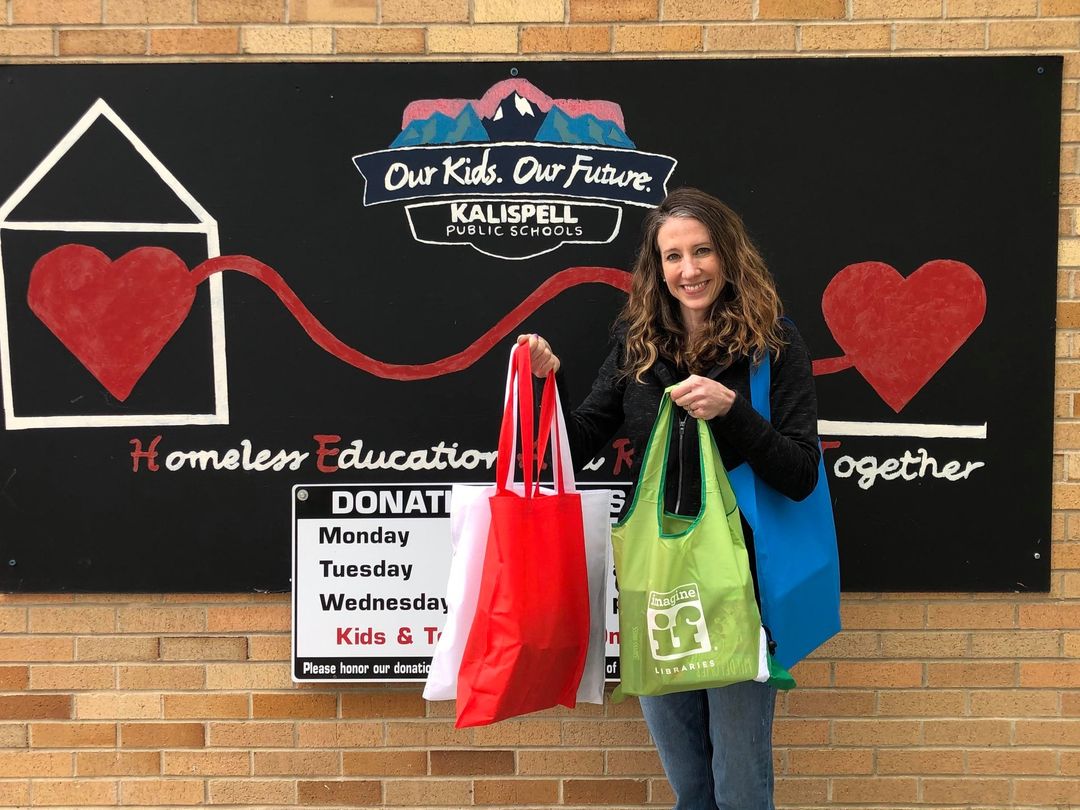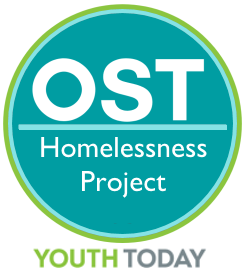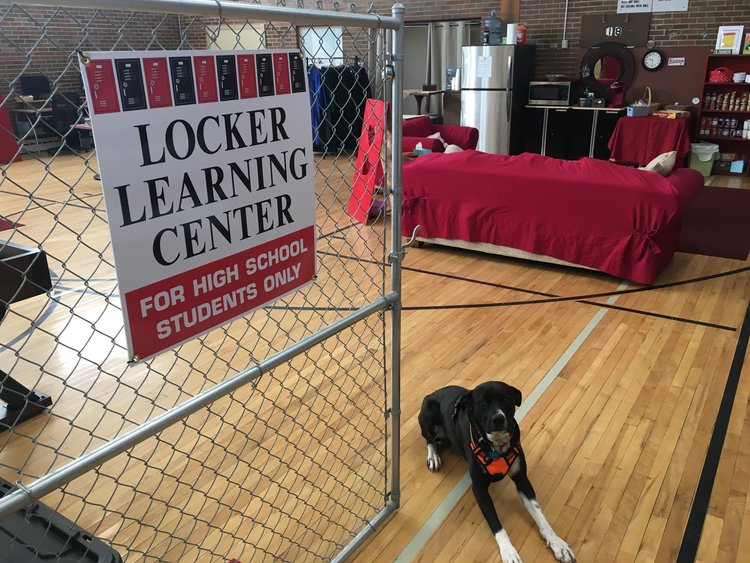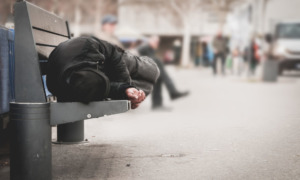
Photos by Kalispell HEART Program
Nichole Heyer, homeless education liaison for the Kalispell and Evergreen school districts, holds materials donated by the local library to the Kalispell HEART Program, which she directs.
(EDITOR’S NOTE: This is the second of several articles in an occasional series about the intersection of OST and students experiencing homelessness.)
On the last day of school in June last year, more than 500 people turned out for a block party in downtown Kalispell, Montana. The streets were thronged. Kids scaled a rock climbing wall.
Community organizations, including ImagineIF Libraries and Serious Juju Skate Park, set up booths with information about their services and summer programs.
 “The entire community was invited,” said Nichole Heyer, director of Kalispell HEART Program, which sponsored the event
“The entire community was invited,” said Nichole Heyer, director of Kalispell HEART Program, which sponsored the event
“Parents and kids can just walk up and down collecting flyers and talking to social service agencies … so that they kind of know what’s available,” Heyer said.
The HEART Program is a nonprofit that does far more than host an end-of-school block party. Embedded in the Kalispell and Evergreen school districts, it provides services for students and families without stable housing.
It meets a range of needs for students and brings people together across the gap between poverty and affluence. It appears to be one of the reasons the graduation rate for homeless students in the Kalispell district rose 14 percentage points over four years up to 74.6%, based on figures from Heyer.
Across the United States youth homelessness is on the rise. The latest figures — prior to the pandemic — show more than 1.5 million school-age kids without stable housing, an 11% increase over the previous year.
Kalispell is a special example. It’s a tourist destination in rural Montana’s Flathead Valley near Glacier National Park. An influx of new residents has pushed housing prices into the unaffordable range for some teachers, firefighters and other full-time workers.
“I’m just inundated with calls right now of families who are looking for help with the propane bill, who are really needing winter gear and extra blankets and things of that nature,” Heyer said. “It’s just becoming increasingly difficult to make it here.”
Heyer, a school district employee, is the homeless education liaison for the Kalispell and Evergreen districts.
She developed the HEART (Homeless Education and Resources Together) Program from an earlier effort begun by a group of teachers.
A place to get what you need
It includes the HEART Locker, a free store of donated clothing and other items; the HEART Market, an in-school free source of food and snacks for students, and the HEART Learning Center, a drop-in after-school space where kids can relax, use computers, get access to resources and meet for programming. Operating expenses are paid by Kalispell Public Schools. An additional program, the HEART Fund, is supported by community donations and provides emergency assistance for things such as rent and gas.
Students can simply walk into the HEART Locker and get what they need. Its one rule is: Take what you need and use what you take.
When parents enter the HEART Locker, they get a warm welcome.

The HEART Learning Locker is a center where students can gather after school to relax, get access to resources, use computers and meet for programming. It’s a project of the Kalispell HEART Program, which also has a free store where students and families can find clothes and other items they may need.
“I can shake their hand — pre-COVID — and look them in the eyes and tell them how excited I am, and the school district is, to have their children in our school and participating,” Heyer said.
The drop-in center has programming, including what Heyer calls a social-emotional learning group. The group has discussions, guest speakers, art therapy and other activities.
AmeriCorps volunteer Casey Driscoll sets appointments with students at the center, helps them fill out job applications and put together resumes.
“The HEART Program serves many more than just our homeless student population. When you open a program like this within a school district, you very quickly realize that you are the poverty liaison,” she said. A family may find housing, for example, but then find they can’t afford the rent, she said.
The nonprofit builds a bridge between the school district and social services. It’s a way to engage families and students in their own education.
Harder to graduate when housing is unstable
Schools are a first site of support for homeless children and youth, according to Barbara Duffield of SchoolHouse Connection, a national nonprofit dedicated to overcoming homelessness through education.
She sees school as the great equalizer and education as critical to providing a way out of homelessness and poverty.
But for students who are homeless, school is chock-full of barriers, and the graduation rate is low. Nationally, only 67.5 % graduated on time, the lowest rate of all subgroups of students, according to data from the National Center for Homeless Education.
To do well in high school and to graduate, kids need to have both basic needs and academic needs met. Students can easily fall behind academically because of frequent moves, absences or other interruptions in schooling.
The McKinney-Vento Homeless Assistance Act requires each school district in the country to have a homelessness liaison, an employee who ensures that homeless kids are enrolled despite barriers (such as a lack of a fixed address) and can fully participate in school. Districts must identify kids who are homeless.
An additional barrier is the feeling families may have of being unwelcome at school or in the community or of not fitting in.
“Maybe they’ve got some piercings or tattoos, or they’ve dealt with addiction issues or mental health issues, and they would normally kind of shy away from coming into the school,” Heyer said.
“I think in education they talk a lot about that parental engagement meaningful engagement. And, but there really isn’t the space or place to make that happen. And [the HEART Program] allows for that. It’s very cool.”
On the HEART Program’s Facebook page, a mother posts asking how to get winter gear for her young son.
A local Girl Scout Troop is shown donating money the Girl Scouts raised for a trip they no longer can take because of the COVID-19 pandemic.
A financial services company is thanked for providing dozens of hoodies.
And an announcement from the HEART Program:
“Attention, community members and donors! The HEART Locker is currently in need of new socks for boys and young men.”
There’s a give and take at the HEART Locker. Shoppers are asked to return items when their child outgrows them so that they can be contributed to someone else.
In addition to meeting some basic needs, Heyer sees the nonprofit as a priceless opportunity to get parents into a partnership together.
“The truth is that the school district can’t do their job without that partnership,” she said. “And these are the parents that we need to be connecting with more so than any other parents.”





























